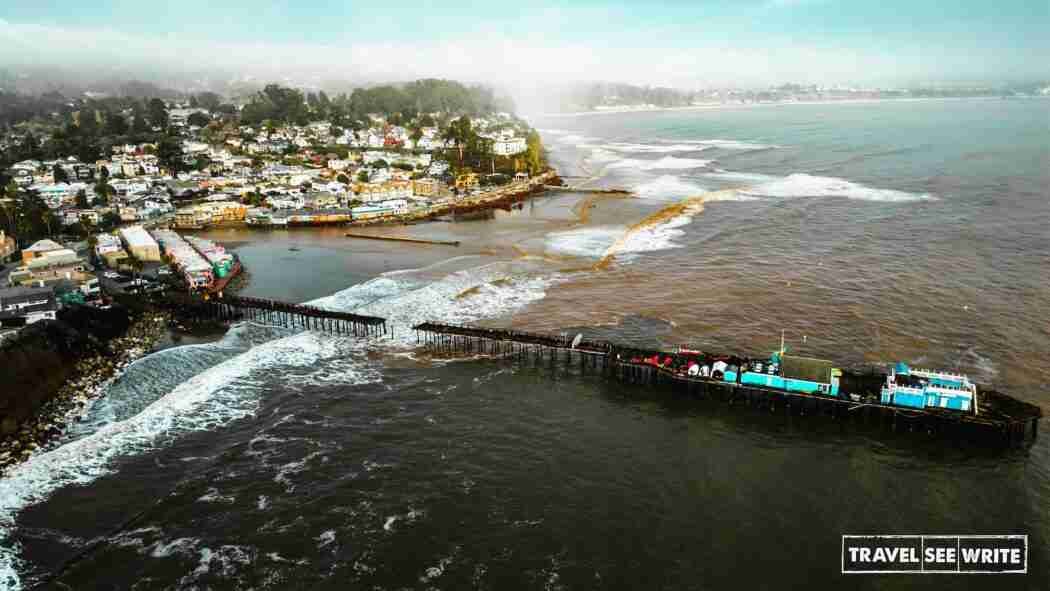
As a traveller, I have always been fascinated by the beauty of California. However, in January 2023, my trip to California took an unexpected turn. The Golden State experienced severe flooding in many regions, and unfortunately, my Central Coast Road trip coincided with the floods, and I had to change my travel plans accordingly. You can read more about that in my previous blog post. I will share what I witnessed during the California floods in this article. Despite a fury of storms, what pleasantly surprised me was how quickly California recovered with no or minimal damage to tourism infrastructure.
Although, over the years, natural disasters have become a common phenomenon across the world, the California floods in January 2023 made a lot of headlines. A sequence of nine atmospheric rivers hammered California during a three-week period in January 2023, bringing over 700 landslides (although most caused minor inconvenience for a few days only), power outages affecting more than 500,000 people and causing financial damages now expected to exceed $30 billion. The floods in California in 2023 were a result of heavy rainfall from December 31, 2022, to January 25, 2023, in a small time window – 400% to 600% above average in that time – caused several rivers and streams to overflow their banks, leading to severe flooding in many parts of the state. Most impacted were parts of Southern California, the California Central Coast, Northern California, and Nevada. In the first ten days of January, at least 20 people died in California storms and flooding — more than the number of civilians who died in wildfires in the last two years.
California’s Central Coast was one of the areas most impacted by the heavy rain, and I happened to be travelling through the region in Santa Cruz, San Jose, Monterey, Paso Robles, and Oxnard. In this article, let me share what I witnessed during the California floods.
Flooding In San Jose
San Jose, the largest city in Silicon Valley, was one of the areas heavily affected by the California floods. While I was there, the floods caused significant damage to the city’s infrastructure, with roads and highways temporarily washed out, homes lost power, and major roadways turned into impassable rivers leading to school closures and limited mobility exacerbated by fallen trees and mudslides. High winds gusting to nearly 50 miles per hour, accompanied by heavy rain and thunderstorms, battered Santa Clara County.
Due to torrential rainfall, I couldn’t get out for days. Restaurants closed early, and food deliveries were unavailable. Those without cars could not even get to nearby stores, and there were flood warnings everywhere. I was stranded in my apartment, and it was impossible to move around.
Flooding In Santa Cruz
Similarly, Santa Cruz, a coastal city in Central California, was one of the hardest hit by the floods. The town experienced significant damage to its infrastructure, including roads, bridges, and buildings. The city’s downtown area was also heavily affected, with many shops and restaurants forced to close their doors temporarily. When I was there, I was confined to my hotel Dream Inn as there was a major flood warning. The Henry Cowell Redwoods State Park was temporarily closed, and part of the scenic 3-Mile Drive was washed out.
One of the most notable landmarks affected by the floods in Santa Cruz was the iconic Capitola Wharf. The wharf, a popular spot for fishing and recreation for over a century, was severely damaged by the flooding and is now unusable for at least a year. The Capitola Wharf is a beloved icon in the community, and its destruction has been deeply felt by locals and visitors alike. The wharf had been a gathering place for generations of families, who come to fish, picnic, and enjoy the beautiful views of the coastline.
The damage to the wharf is just one example of the extensive destruction caused by the floods in Santa Cruz. Many homes and businesses in the area were also severely impacted by the flooding.
But now things are back to normal. Just last week, my friends were holidaying at my favourite spots and shared lovely pictures from the wharf and pier.
Flooding In Monterey Bay
Monterey County, the scenic coastal area about 100 miles south of San Francisco that includes Big Sur and the famed golf courses of Pebble Beach, too was heavily impacted by California flooding. Highways 1 and 68 were the most vulnerable to flooding from the Salinas River. More than 17,000 residents living in low-lying areas near the river were ordered to evacuate temporarily, and six emergency shelters were set up for evacuees.
The city’s famous Cannery Row area was inundated by seawater. Some of the historic buildings in the area suffered damage; however, luckily, all businesses in the area are now reopened.
All sea adventures were closed, including my anticipated whale-watching tour, but as they say – better safe than sorry.
Here’s a video about the flooding in Monterey County, California:
Flooding In Paso Robles
Further inland, Paso Robles experienced severe flooding, with the Salinas River overflowing its banks and causing widespread damage to homes and businesses. Within 24 hrs, over 2 inches of rain and flooding caused disruption to transportation in the area, with many roads closed due to high water levels, including the Northbound and southbound Highway 101, 10th Street, 13th Street, San Marcos Road etc. Adelaida Road, Nacimiento Lake Drive and Peachy Canyon Road were all flooded. Also, despite the reduced flood warnings and rain subsiding, it took work to traverse the county roads. I had to take so many detours to navigate through the town.
Flooding In Oxnard, Ventura County
Finally, Oxnard, located on the coast, was hit hard by the floods, with the Ventura River overflowing and causing damage to some homes and businesses in the area. The city’s agricultural industry was also affected, with several farms and fields submerged underwater. The county had not seen this kind of water in the last 28 years. The banks of the creek at Foster Park broke due to overflowing water, flooding picnic areas and hiking trails. Ventura Pier was temporarily closed to protect the public from the upcoming storms.
The 101 Freeway was fully closed between State Route 33 in Ventura County and State Route 150 in Santa Barbara County due to flooding on January 10 2023. Even State Route 126 was closed as a mudslide hit the area, trapping several vehicles, including a big rig. The good news is all the roads reopened very quickly and welcomed tourists like before.
The hotel where I stayed had water seeping into its parking lot and elevator. All the sea tours to the Channel Islands were called off due to heavy rainfall, rough sea and poor visibility.
Overall, my trip to Ventura County could have been at a better time. There were so many places I wanted to check out, such as the Channel Islands National Park, Ventura Botanical Gardens, and Oxnard Beaches. I am definitely going to return to the county to see what I sadly missed this time.
Reason for California Floods
The floods in California in 2023 were caused by a combination of factors, including heavy rainfall and melting snowpack in the Sierra Nevada mountains. Climate change is also believed to have played a role, with rising temperatures leading to more intense rainfall events. From December 2022 to January 2023, California’s weather abruptly switched from extreme drought to extreme flooding.
But it isn’t just California that’s facing the brunt of climate change. It’s no secret that the tourism sector is highly vulnerable to climate change, and extreme weather from climate change is impacting tourism destinations across the world. It’s an environmental crisis that can’t be solved by consumers alone; governments, hotels, tour operators, cruise operators and the aviation industry need to lead with additional policies to encourage better decision-making.
What next?
Despite the devastation caused by the California floods of January 2023, there were some silver linings. Firstly, the torrential downpours over California this year quenched some thirst of the state that was facing a severe drought. Secondly and most importantly, communities came together to support one another, and there were countless acts of kindness and generosity. During these difficult times, we realize the importance of standing together and helping each other. The floods may have caused significant damage, but the Californian people’s resilience and strength have helped them bounce back. Thirdly, the state handled the situation well and ensured that the businesses and infrastructure is up and running quickly without causing any long-term damages.
Natural disasters are a stark reminder of the importance of emergency preparedness and response. As the world continues to face the challenges of climate change and other natural disasters, it is essential that we remain vigilant and prepared for whatever the future may hold.





